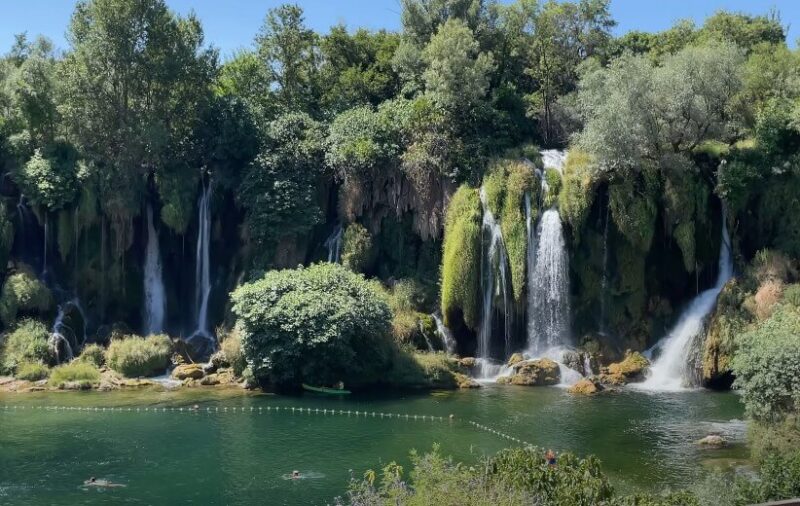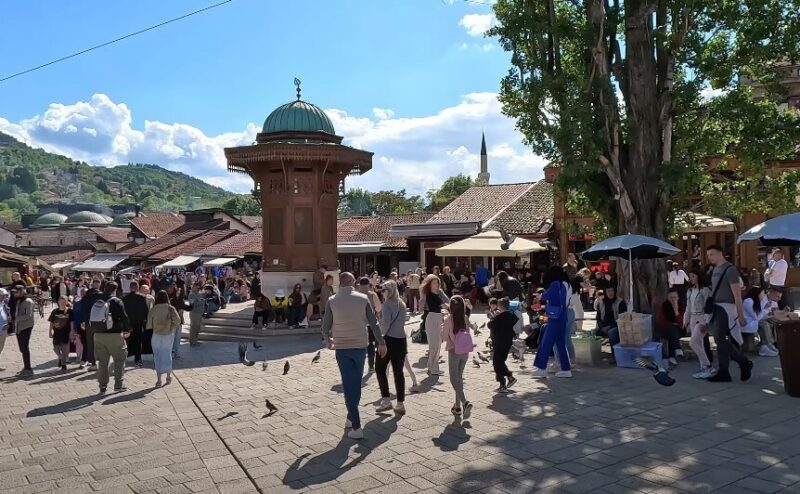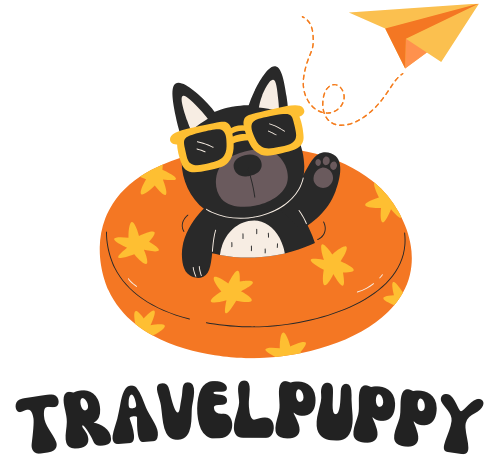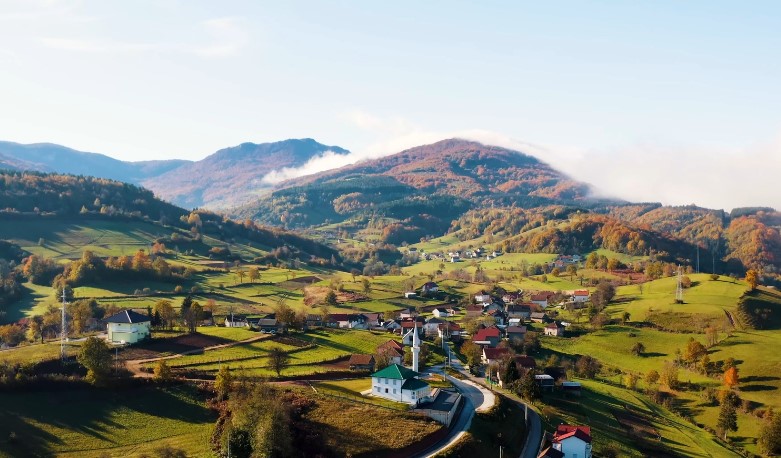Bosnia and Herzegovina doesn’t always make the top ten lists in glossy travel magazines, but it should. Tucked between Croatia, Serbia, and Montenegro, this Balkan treasure has a way of catching you off guard with its beauty, depth, and generosity.
In 2025, with easier access, global recognition, and an uptick in tourism, it’s the right moment to explore before the crowds reshape it.
From history-soaked streets to wild mountain landscapes, here’s why the country deserves a serious spot on your travel plans.
Key Takeaways
- Sarajevo, Mostar, and Jajce offer living history through landmarks, museums, and UNESCO sites.
- Kravica Waterfalls, Sutjeska, and Una National Park showcase unspoiled natural beauty.
- Traditional food is hearty, flavorful, and among the most affordable in Europe.
- 2025 brings easier access and rising tourism, making now the ideal time to visit.
History That Feels Alive

Bosnia and Herzegovina carries centuries of layered history – the kind you don’t just read about, you walk through.
Ottoman minarets share skylines with Austro-Hungarian facades, while streets carry echoes of the 1990s conflict.
Sarajevo
Sarajevo’s history books are written into its street corners. At the Latin Bridge, a plaque marks the assassination of Archduke Franz Ferdinand in 1914, the spark that ignited World War I.
Not far away, the Tunnel of Hope Museum preserves a lifeline from the city’s 1,400-day siege during the Bosnian War, complete with original wooden panels and everyday objects smuggled through.
Mostar and Its Bridge of Resilience
The Stari Most in Mostar is an architectural gem and a symbol of recovery.
Destroyed in the war and rebuilt in 2004, the bridge draws summer crowds to watch daredevils leap into the Neretva River from 24 meters up.
Other Historical Highlights
- Jajce – A medieval fortress town where a waterfall drops right in the center.
- Višegrad – Home to the Mehmed Paša Sokolović Bridge, a UNESCO-listed Ottoman masterpiece.
- Srebrenica Memorial – A sobering reminder of the 1995 genocide, with guided tours that focus on remembrance and peace.
Nature That Demands Exploration

Bosnia and Herzegovina’s landscape is an open invitation to hikers, skiers, rafters, and anyone who simply likes breathing in crisp, mountain air.
Around half the country is forest, and much of it feels untamed.
Top Natural Attractions
| Attraction | Location | Key Activities | Best Season |
| Kravica Waterfalls | Near Ljubuški | Swimming, picnicking | Spring/Summer |
| Sutjeska National Park | Southeast | Hiking, wildlife viewing | Summer/Fall |
| Una National Park | Northwest | Rafting, kayaking | Summer |
| Jahorina Ski Resort | Near Sarajevo | Skiing, snowboarding | Winter |
| Hutovo Blato Reserve | South | Birdwatching, boating | Spring/Fall |
For Adventure Seekers
- Maglić Peak in Sutjeska challenges seasoned hikers while offering staggering views.
- Rakitnica Canyon mixes adrenaline with scenery for canyoning enthusiasts.
- Una River rapids give rafting trips an unforgettable twist.
Even the country’s 20-kilometer Adriatic coastline at Neum offers a quiet beach break, often at a fraction of the price of nearby Croatia.
Culture That Welcomes You In

Few places match the cultural blend of Bosnia and Herzegovina. In Sarajevo, you can walk from a mosque to a synagogue to a Catholic church and then an Orthodox church in minutes.
The country’s mix of Bosniak, Croatian, and Serbian traditions creates a rich social fabric.
Where Culture Comes Alive
- Baščaršija Bazaar – Sarajevo’s Ottoman-era market district where coppersmiths hammer away at intricate coffee sets.
- Sarajevo Film Festival – One of Europe’s leading cultural events every August.
- Bascarsija Nights – A month-long July celebration with music, dance, and food.
- Mostar Summer Events – From jazz to folk festivals.
- Međugorje – A global pilgrimage site drawing spiritual travelers year-round.
Hospitality here isn’t a marketing slogan – it’s woven into everyday life. Staying in family-run guesthouses often means leaving with a few new friends and at least one invitation to return.
Food Worth Traveling For

If you travel for flavors, Bosnia and Herzegovina’s kitchen won’t let you down. Meals are hearty, affordable, and deeply satisfying.
Local Favorites and Prices
- Ćevapi – Small grilled meat sausages served in somun bread (€3-€7).
- Burek – Flaky pastry filled with meat, cheese, or spinach (€1.50-€3).
- Sarma – Cabbage rolls stuffed with minced meat and rice (€4-€6).
- Klepe – Bosnian dumplings, often served with garlic sauce (€4-€6).
- Tufahija – Poached apple with walnuts and cream (€1.50-€2).
Drinks are just as inviting:
- Bosnian coffee – Served strong with sugar cubes (€1).
- Rakija – Local fruit brandy (€1-€2 per shot).
- Žilavka wine – A crisp Herzegovinian white perfect with grilled fish.
Even in well-known tourist spots, a full meal with drinks rarely tops €20.
Travel Without the Budget Stress
One of the best parts about traveling here is how far your money goes. Compared to Croatia or Montenegro, expect about 50 percent lower costs for accommodation, food, and activities.
Sample Daily Budget
- Accommodation: €23 (shared double room)
- Food: €12 (three meals)
- Transport: €9 (local and intercity)
- Activities: €7 (museum entries, tours) Total: €51
Getting Around
- Buses and Trains – Scenic and affordable, especially the Sarajevo-Mostar train (€7).
- Car Rentals – Around €30/day for more flexibility.
- Airports – Sarajevo, Mostar, Tuzla, and Banja Luka are served by budget airlines.
Choosing the Right Season
Each season offers something unique:
- Spring (April-June) – Mild weather (15-25°C), fewer tourists, perfect for hiking.
- Summer (July-August) – Hot (up to 35°C), ideal for festivals, rafting, and swimming.
- Autumn (September-October) – Golden landscapes and wine harvests.
- Winter (November-March) – Ski season on Olympic slopes.
May and September are sweet spots for good weather and reasonable prices.
Staying Safe
View this post on Instagram
Bosnia and Herzegovina is generally safe, but there are a few things to keep in mind:
- Petty theft can happen in busy tourist areas – keep valuables close.
- Landmines remain in some rural zones – stick to marked trails.
- Crowds at football matches or demonstrations can get intense – best to steer clear.
Health services are adequate in cities, and tap water in Sarajevo is safe to drink.
Why 2025 Is the Perfect Year
Tourism is rising fast, with improved flight connections and infrastructure. If you are on a hush trip, don’t worry about internet connection. UK flights alone jumped 300 percent in 2024, and monthly arrivals keep climbing. National Geographic recently highlighted Sarajevo as one of the must-visit destinations, giving the country more international spotlight than ever. There’s still room to explore without feeling crowded, and locals are eager to share their traditions before mass tourism changes the rhythm.
Final Words
Bosnia and Herzegovina is not a destination you tick off a list – it’s a place that stays with you. From a coffee in Sarajevo’s old bazaar to a swim under Kravica’s turquoise cascades, the experiences here are as authentic as they are affordable.
If you want a trip with history you can walk through, nature that still feels wild, and culture that opens its doors, make it your next stop. You’ll leave with more than photos – you’ll leave with stories.

